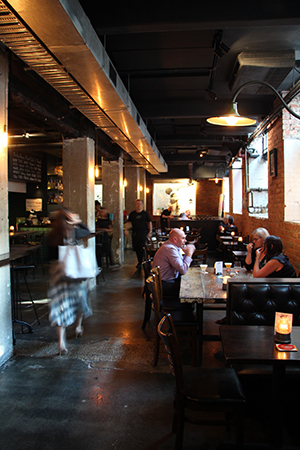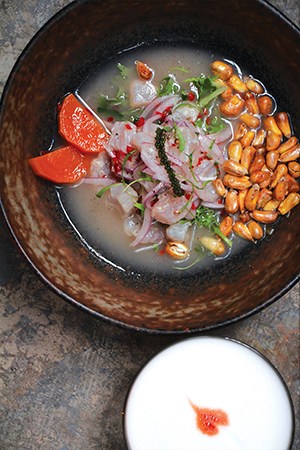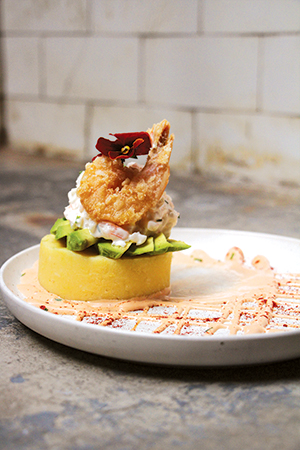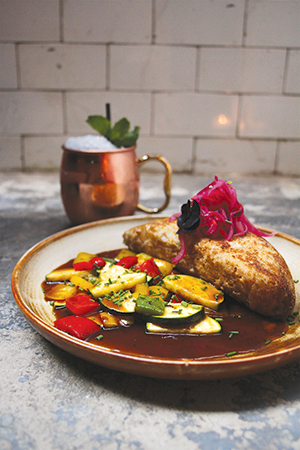2020/04/01
NYスタイルの空間で王道のペルー料理 を- Harley House(2020年04月号)
メルボルンにはたくさんの隠れ家的な店が存在する。今回紹介 するペルー料理&バーのHarley Houseも、そんな隠れ家レストラ ンのひとつ。小さな入り口から地下に降りると、想像以上に天井が 高く、ゆったりとしたボックスシートが並んでいる。気さくに出迎え てくれたのはマネージャーのJonnyさん。「この店は、レストランと バーどちらも兼ねていて、自分もカクテルを考案します」とか。今回 は、彼、お勧めの料理とカクテルをいただいた。

最初に運ばれて来たのは、ペルー産の蒸留酒『Pisco』を使った カクテル2種。Pisco Muleは、ミントとライムの爽やかな風味が効い た清涼感のある味わい。さっぱりした口当たりで飲みやすいのが 特徴。Pisco Sourは、卵白の泡とドリンクが2層になった見た目にかわいらしいお酒。ちょっぴり甘いので、女性受けしそう。
料理は、ペルー料理の代表とも言えるCevicheから、Ceviche Tradicional。ペルーの先住民の間では、生魚を食べる習慣があり、 そこにスペインからもたらされたオニオンとレモンが加わり、現在 のCevicheになったそう。白身魚をレモンやライムの果汁でマリネ するので臭みもなく、微かに唐辛子のピリッとした辛さがクセにな る。一緒に添えられたコーンナッツを炒ったChulpiの香ばしさや 食感も良いアクセントになっている。

Ceviche Tradicional $23 & Pisco Sour $20
続いては、ペルー版ポテトサラダで、見栄えも良いCausa de Langostino。マッシュポテトの中に少量のチリを入れたものを Causaと呼び、さまざまな具と組み合わせる家庭料理。今回はエビ とアボカドが使われていた。ポテトとエビの入ったタルタルソースのコンビネーションが絶妙で、独り占めしたくなること間違いなし。

Causa de Langostino $18
最後は、アフリカ料理と中華料理が融合したようなTacu Tacu de Frejoles。アフリカ人が食べていた豆と米のスペイン風オムレ ツTortillaに、中華料理に出てきても違和感のない甘酢系のトロミ のあるソースで炒められた野菜が添えられている。オムレツとスフ レの中間のようなTortillaはホウホクしていてボリュームたっぷり。 中華風のソースとも相性抜群で、食べ出したら止まらない。

Tacu Tacu de Frejoles $26 & Pisco Mule $19
新鮮な魚介類や野菜、果物などをふんだんに使ったペルーの先 住民の食文化に、スペイン、アフリカ、イタリア、中国、日本などの食 文化が混ざり合って形成されたペルー料理が楽しめる。ちょっぴり 自慢げに友達を連れて行きたくなる店。ごちそうさま。
Traditional Peruvian Food Served in a New York-style Restaurant
Melbourne is full of hidden gems. And this month’s establishment, Peruvian restaurant and bar, Harley House, is definitely one of those. With its tiny entrance that leads you underground, it’s definitely a surprise to be greeted by a large, airy space, with tall ceilings and rows of booths. Welcomed by the friendly manager, Jonny, we were informed that because this was both a restaurant and bar, he could recommend cocktails, as well as regular dishes. Thus we embarked on a journey through his suggestions.
First up, two cocktails using Peru’s famous spirit, Pisco. The Pisco Mule’s mint and lime gave it a cool, refreshing taste that was very easy to drink. The Pisco Sour was sweeter, both in looks and taste, with its cute, dual-layered aesthetic (thanks to the egg white foam on top) creating a drink that should be popular with the ladies.
For our food we started with the Ceviche Tradicional. Ceviche is probably Peru’s most famous dish, created by fusing indigenous Peruvians’ taste for raw fish, with the Spanish Conquistadors’ imported onions and lemons. Because it’s marinated in lemon or lime juice, the white fish has no unpleasant aroma, and thanks to the hint of chilli pepper, it has an addictive little kick. The accompanying Chulpi, made with toasted corn nuts, had a lovely aroma and texture to it too.
Next we tried what is essentially a Peruvian potato salad ‒ the gorgeous Causa de Langostino. The ‘Causa’ is mashed potato with a little bit of chilli mixed in, which can then be paired with a myriad of other ingredients. This particular take on the home-cooked classic uses prawns and avocado. The tartare sauce, which has scallop and prawn mixed in, is sublime, and overall, it’s a dish you won’t want to share.
Finally, we had the Tacu Tacu de Frejoles, which, strange as it sounds, almost comes across as a mix of Spanish and Chinese cuisine. By mixing castilla beans and rice in a fluffy, filling tortilla that’s halfway between an omelette and a soufflé in texture, and stir-frying the accompanying vegetables in a thick, sweet and sour-style sauce, you get this beautiful fusion you can’t stop eating.
By combining traditional Peruvian cuisine, with its fresh seafood, vegetables and plentiful fruit, with Spanish, African, Italian, Chinese, Japanese and other influences, Harley House offers a new take on Peruvian dining. It’s the kind of establishment you want to take a friend to, just to show off. Gochisousama.
Harley House
Basement 71 Collins St, Melbourne (Entry via Strachan Lane off Exhibition)
T: 03 9663 8333
Wed~Sat from 12pm, Tue~Sat from 5pm
| Before each meal in Japan, you say ‘itadakimasu’, and afterwards, ‘gochisousama’. Itadakimasu conveys your gratitude to both the ingredients that gave up their lives to feed you, and everyone involved in bringing you your food. Gochisousama, meanwhile, conveys thanks purely to the people who prepared and served your meal. |

